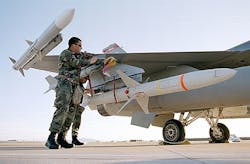Navy orders EW missile-control computers for U.S. and Australian combat aircraft
PATUXENT RIVER NAS, Md., 2 Sept. 2014. Military avionics experts at the Raytheon Co. will provide airborne computers that link sensors aboard the U.S. Navy Boeing F/A-18E/F and EA-18G combat aircraft and the Raytheon AN/AGM-88 anti-radar missile.
Officials of the Naval Air Systems Command at Patuxent River Naval Air Station, Md., announced a $24.6 million order Thursday to the Raytheon Missile Systems segment in Tucson, Ariz., to provide 158 command launch computers for the AN/AGM-88 high-speed anti-radiation missile (HARM). The order involves 121 command launch computers for the U.S. Navy and 37 of the computers for the government of Australia.
The Raytheon CP1001 HARM command launch computer provides the digital interface between the AN/AGM-88 HARM anti-radar weapon and the F/A-18E/F and EA-18G aircraft. the FA/18E/F Super Hornet is a carrier-based jet fighter bomber, while the EA-18G Growler is a carrier-based electronic warfare jet.
The CP1001 HARM command launch computers act as intelligent MIL-STD-1553B bus terminals; they translate protocols between the HARM computer and the MIL-STD-1553B databus, as well as provide other HARM-specific functions.
Related: Raytheon completes tests of the HARM control section modification upgrade
The HARM command launch computer couples tightly to the FA/18E/F and EA-18G radar warning receivers and queue active threats automatically. The HARM command launch computer helps decide which targets to attack, transmits data to the missile, and launches the AGM-88 HARM anti-radar weapon. HARM is designed to sense and destroy enemy radar installations.
The HARM command launch computer receives target data from the missile and onboard avionics, processes the data for display to the aircrew to the appropriate display, determines target priority, and collects aircraft data for pre-launch hand-off to the AGM-88 HARM missile.
The computer determines time coincidence between the AGM-88 HARM missile and the radar warning receiver's directional data and pulse repetition intervals and formats. The computer processes identification data to identify targets and rank them in order of importance, and then displays information to the air crew.
Related: HARM anti-radar missile moves ahead with planned upgrade to dual-mode seeker
The Raytheon AGM-88 HARM is a joint U.S. Navy and Air Force program. Its primary mission is to suppress or destroy surface-to-air missile radar and radar-directed air defense artillery systems. Once airborne, it can operate in three modes: preemptive, missile-as-sensor, and self-protect.
The missile is employed on a variety of Navy, Air Force, and Marine Corps aircraft including the F-16 and F/A-18. Raytheon is developing a HARM upgrade, called the HARM Control Section Modification (HCSM), which adds a GPS receiver and an improved inertial measurement unit for precision navigation.
HCSM also features a digital flight computer that merges targeting solutions from navigation and seeker systems. The enhancements improve the probability of hit, while controlling where the missile can and cannot fly.
On this order Raytheon will do the work in Tucson, Ariz., and should be finished by February 2018. For more information contact Raytheon Missile Systems online at www.raytheon.com, or Naval Air Systems Command at www.navair.navy.mil.

John Keller | Editor
John Keller is editor-in-chief of Military & Aerospace Electronics magazine, which provides extensive coverage and analysis of enabling electronic and optoelectronic technologies in military, space, and commercial aviation applications. A member of the Military & Aerospace Electronics staff since the magazine's founding in 1989, Mr. Keller took over as chief editor in 1995.

